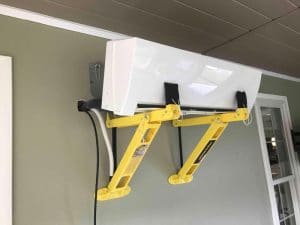Here’s a quick fact: no one wants to spend money on a new air conditioner.
Your air conditioner is an appliance. Just like your refrigerator, your dishwasher, your washer, your dryer, etc. The biggest difference between these everyday appliances and the appliance that keeps you comfortable is the cost. We’re sorry to have to tell you this: your air conditioner (and furnace) are oftentimes the most expensive appliance(s) in your home. However, there are ways to save and ensure you’re getting the highest possible return on your investment.
The Cost of Air Conditioning
The cost to install central air conditioning, including the unit, ranges from around $3,000 to over $9,000 on average. Some homes with multiple luxury units can easily climb into the $20,000+ range.
The price tag varies widely depending on the type of system you need, the condition of your existing air ducts, your existing duct design, your existing electrical setup, the type of fuel available, and more.
What factors affect the cost to install central air?
The price of an air conditioning unit is only one piece of the total cost to install central air. It may be possible that you need air ducts installed or modifications may need to be made to your current ducts. You’ll also need a qualified professional from Spurk HVAC to perform the work.
A Manual J load calculation is the first step in proper installation.
Simply put, Manual J is a process developed by the Air Conditioning Contractors of America (ACCA) to accurately assess how much heating and cooling your home needs. Prior to Manual J, most contractors and homeowners relied on the traditional “rule of thumb,” resulting in HVAC choices that weren’t as efficient or cost-effective.
In fact, in many older homes here in the Greater Pittsburgh area, we see an astounding amount of units that are grossly oversized or vastly undersized.
An accurate load calculation also makes choosing a new HVAC system much easier. Armed with the results, you can narrow down your HVAC choices and pick a system that offers the best efficiency and performance for your home.
After the Manual J load calculation, your contractor should check the systems an air conditioner relies on, especially ductwork, and ensure they can handle central air.
Existing ducts sometimes can’t handle the airflow of a modern air conditioner. Your home may also lack space to run a refrigerant line to the exterior, or room for an air conditioner coil or properly-sized vents.
Any upgrades or modifications to accommodate the new system will likely increase the total cost to install central air conditioning, but they can help you avoid high energy bills and hot rooms.
The Equipment
After home performance and support systems are evaluated, it’s time to select an air conditioning unit. Depending on the size and structure of your home, you’ll choose from the following types:
- Ductless Systems (Often referred to as Ductless Mini-Splits, Ductless Heat Pump, Etc.)
- These have three main elements: the condensing unit, the evaporator coil, and the air handler. The condensing unit is placed outside and looks like a big metal box with a fan in it. The evaporator coil and air handler live inside. Split systems are most economical in homes that already have a furnace, and are generally quiet, efficient, and affordable to maintain.
- Standard Central System
- The most common in our area, a standard central system consists of an outdoor condenser unit and an indoor furnace.
- Heat Pumps
- They act as both an air conditioner and furnace. Heat pumps can be an efficient option, especially when combined with an existing gas furnace (called a hybrid system). Standalone heat pumps are best suited for mild climates. The heat pump extracts hot air from your home and dumps it outside in the summer, then pumps outdoor heat inside during the winter. Hybrid systems essentially act as a team. If the weather gets extremely cold the paired furnace will kick on to help the heat pump satisfy the thermostat.
Size
In addition to type, the cost of a central air unit varies by size. An air conditioner’s capacity to cool the air is measured in tons; residential systems are generally available in 1.5- to 5-ton capacities. Bigger isn’t always better; your air conditioner’s size should be determined by the load calculation mentioned above.
Don’t choose an air conditioning unit based solely on its Seasonal Energy Efficiency Ratio, or SEER rating, either. An air conditioner with a high SEER rating costs more up front but will still waste energy if it’s improperly installed.
Related: Buyer’s Guide Replacing Your Air Conditioning
An HVAC contractor’s business size and location affect the cost to install central air conditioning. We strongly recommend you don’t get too hung up on finding the lowest bid.
We’ve all heard the trite phrase (or some variation of it), “If it’s good and cheap, it won’t be fast. And if it’s fast and cheap, it won’t be good.”
Finding an HVAC professional who does the job right the first time is worth the time and expense.
To find a high-quality HVAC contractor:
-
Read online reviews and ask friends for referrals
-
Search for contractors on the ACCA website (and use this checklist to guide the conversation)
-
Compare estimates from at least three different companies
- Ask lots of questions about their qualifications and standards
Related: Buyer Beware, The Hidden Cost of Cheap
3 tips to control central air conditioning installation costs
1. Examine your cooling needs
If you’re an empty nester or only home at night, consider a ductless mini-split air conditioning system. These systems combine an outdoor compressor and condenser with indoor blower vents that can be installed on just about any exterior wall. If ductless isn’t your speed, check out all of the available smart air conditioning technology or schedule a free consultation with Spurk HVAC.
Related: Smart Air Conditioning: Buyers Guide
2. Time it right
HVAC contractors are always busy during the hottest and coldest months. Scheduling installation in the off-seasons — spring and fall — may yield faster turnaround time because workers aren’t as busy. There have been some exceptions to this traditional rule of thumb with COVID-19 messing up manufacturing. Although manufacturers are slowly getting caught up, there is still a shortage of certain pieces of equipment. Your preferred HVAC contactor should have an idea of how long it will take to receive your equipment.
3. Look for equipment rebates and tax credits
Local governments, as well as utility companies and manufacturers, promote the use of high-efficiency air conditioners through financial incentives. Use the Energy Star rebate finder to find money-saving opportunities in your ZIP code.
When all else fails, give us a call or click the button below to get started with your free air conditioning replacement consultation or to schedule service.
ABOUT SPURK HVAC
Spurk HVAC was formed in 2018 and is located in Warrendale, Pennsylvania. We proudly serve Cranberry Twp., Wexford, Gibsonia, Mars, and the surrounding Greater Pittsburgh area.
We service all makes and models. If you are seeking a heating repair, heating system replacement, air conditioner repair, air conditioning maintenance, air conditioning replacement, or any other heating & cooling services. Whether you are looking for residential or commercial HVAC services, we look forward to any and all opportunities to become your preferred HVAC contractor.
















